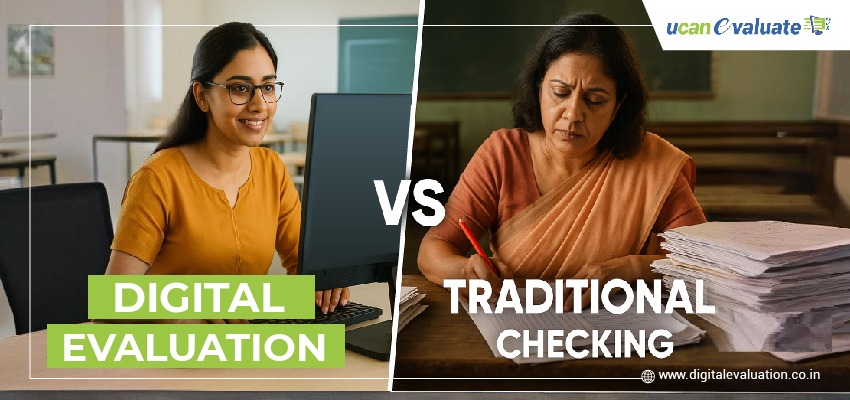Why traditional checking struggles today
- Slow, manual movement of scripts between centers and evaluators increases delays and risk.
- Limited visibility into who marked what, when, and how—making audits difficult.
- Inconsistent quality due to varied mark-scheme adherence and missed pages.
- High logistics cost (transport, storage, TA/DA).
- Security gaps around access control and tracking.
What an On-Screen Evaluation System adds
- Answer booklet scanning converts scripts into secure digital images.
- Role-based access & masking ensure anonymity and integrity.
- On-screen marking tools (tick/cross, comments, highlights) enforce scheme compliance.
- Live dashboards show progress, productivity, and exceptions in real time.
- Complete audit trails (page-wise, time-stamped) for RTI and external reviews.
Head-to-head: Digital Evaluation vs Traditional Checking
Speed & TAT
- Digital: Parallel allocation and online submission compress timelines; rechecks are faster.
- Traditional: Physical movement and batching cause bottlenecks.
Accuracy & Consistency
- Digital: Mandatory page-view, mark-scheme prompts, and secondary reviews reduce human error.
- Traditional: Missed pages and uneven scheme adherence are harder to detect.
Transparency & Compliance
- Digital: Page-level logs, evaluator footprints, and version history simplify audits/RTI.
- Traditional: Trail is fragmented across centers and paper registers.
Scalability
- Digital: Ramp evaluators quickly; allocate scripts randomly to prevent hoarding.
- Traditional: Scale depends on storage, transport, and manual coordination.
Security
- Digital: Identity masking, controlled IP/MAC access, encryption, and expiry policies.
- Traditional: Paper custody and seal-based processes are harder to monitor end-to-end.
Cost & Operations
- Digital: Lower logistics; more oversight per coordinator; better forecasting.
- Traditional: Repetitive handling, travel, and storage inflate costs.
Common challenges—and how to handle them
- Change management for faculty: Use sandbox training, short pilots, and peer champions.
- Infrastructure readiness: Start with hybrid runs; use staggered scanning windows; leverage cloud elasticity.
- Policy alignment: Update evaluation SOPs to include masking, exception handling, and digital approvals.
- Data governance: Define retention, archival, and access policies upfront to meet regulatory norms.
Future trends you should plan for
- AI-assisted checks for rubric prompts, anomaly flags, and missed-page warnings.
- Deeper analytics on evaluator reliability, topic-level performance, and item quality.
- Tighter integrations across Pre Examination Processing, Online Examination System, and Post Examination Processing for a single source of truth.
- Any-time audits with secure, role-based retrieval of script images and mark histories.
Implementation path (fast but safe)
- Pilot a department/semester with clearly defined SLAs and audit goals.
- Scan & validate (non-destructive) answer scripts with QA sampling.
- Roll out on-screen marking with masking, random single-script allocation, and scheme checks.
- Enable dashboards & exports for controllers and coordinators.
- Conduct post-exam review: lessons, metrics, and SOP updates for the next cycle.
Learning Spiral’s digital evaluation stack brings these capabilities together—linking scanning, on-screen marking, audit trails, and downstream result workflows—so authorities can deliver faster, fairer, and fully defensible outcomes.
Ready to modernize evaluation? Request a demo to see how Learning Spiral’s On Screen Evaluation System fits your processes and compliance needs.



